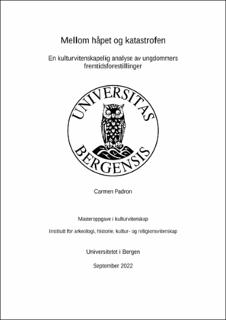| dc.description.abstract | This thesis looks at how eight 17 and 18 year old Norwegian high school pupils imagine their future in a climate-changed future, and how their visions are told as narratives. This is done through qualitative interviews where I focus on narrative theory, and concepts such as Bakhtins dialogism, life-scripts, the various temporalities of the concept «climate change», as well as different concepts emerging from the climate change discourse. The objective of this thesis is to examine how the informants talk about the expectations they have for their own lives and how they reflect on climate change. I examine how the notion of time appears through the narratives of their imagination of the future, how the understanding of the climate crisis and other crises is expressed in the narratives of the imagined future. As well as what possibilities the pupils imagine for a sustainable future.
After analysing the interviews it appears as though the informants operates with multiple futures, that describes and belongs to different parts of life and perspectives. I decided to call the future that includes their personal plans and the life they expect, the personal future. This future existed outside the concern of the rest of society and climate change. The other main future, that I decided to call the climatic future, included their visions for our future society and the course of the climate crisis. The climatic future appears as a common future that embraces both society’s and the world’s future, and exists outside their own personal lives. This future seems to mirror the tendency to view society’s development through a series of crises, a tendency related to late modernity. Where the personal future could be devided into an immediate and a distant future, the climatic future appeared mostly divided by what degree the informants feel they have control over the crisis, and the possibilities they see for crisis management. In a way, this divide can also create a sense of a more distant and a nearer climatic future. These different futures that emerges from the interviews appears as various accessible spheres that the informants can utilize depending on the questions they’re asked. | en_US |
